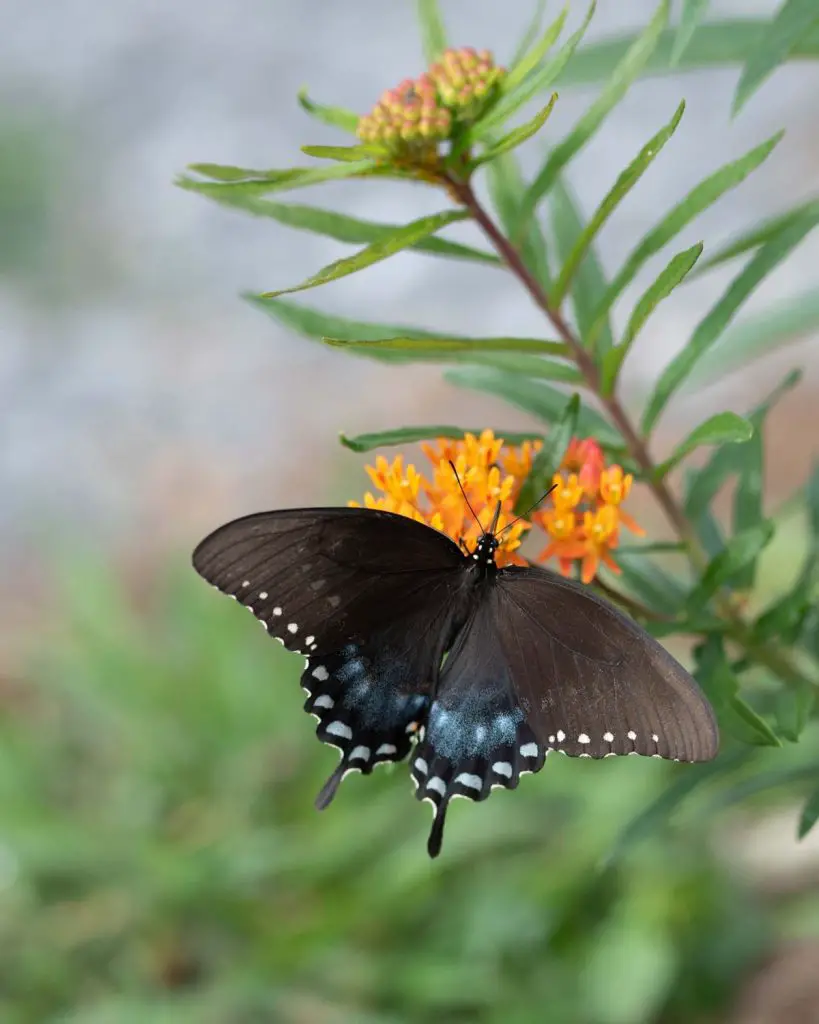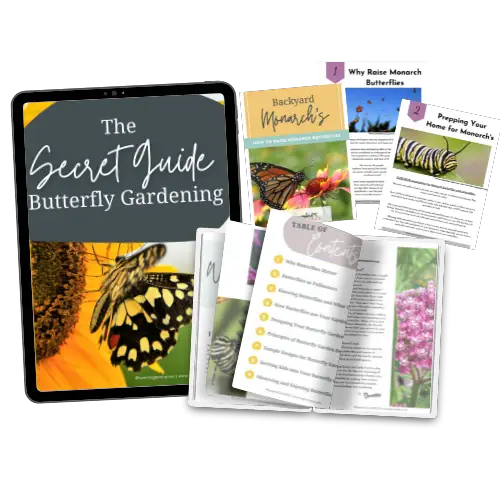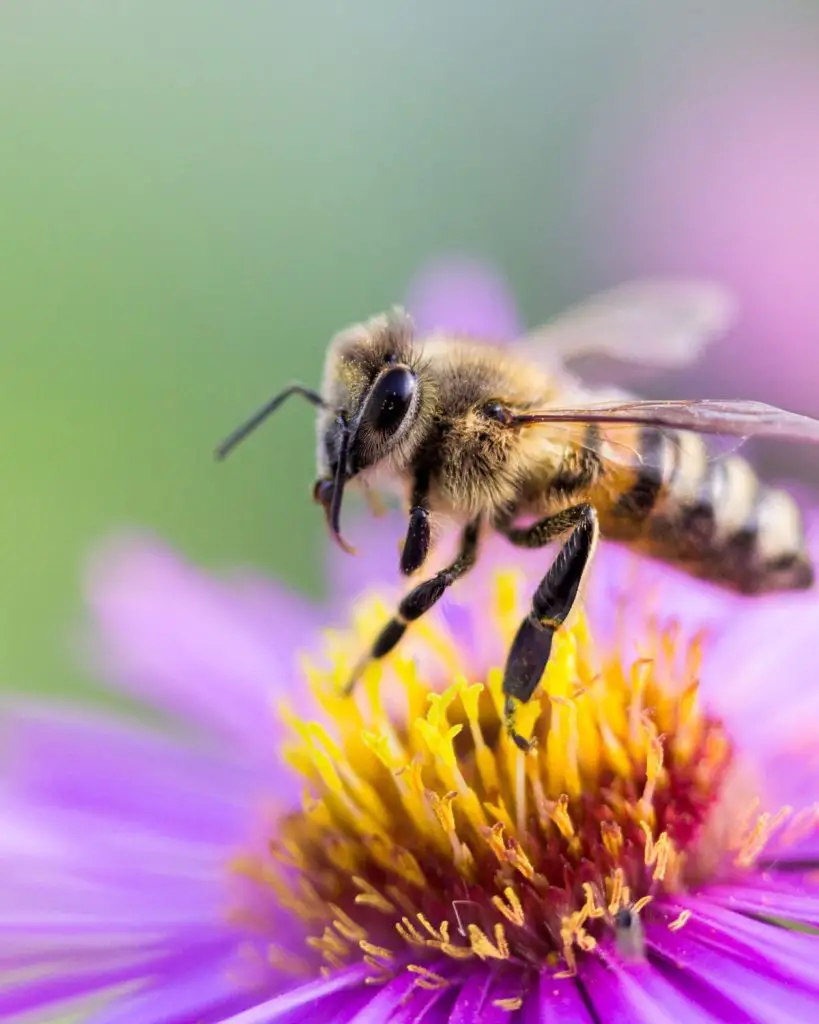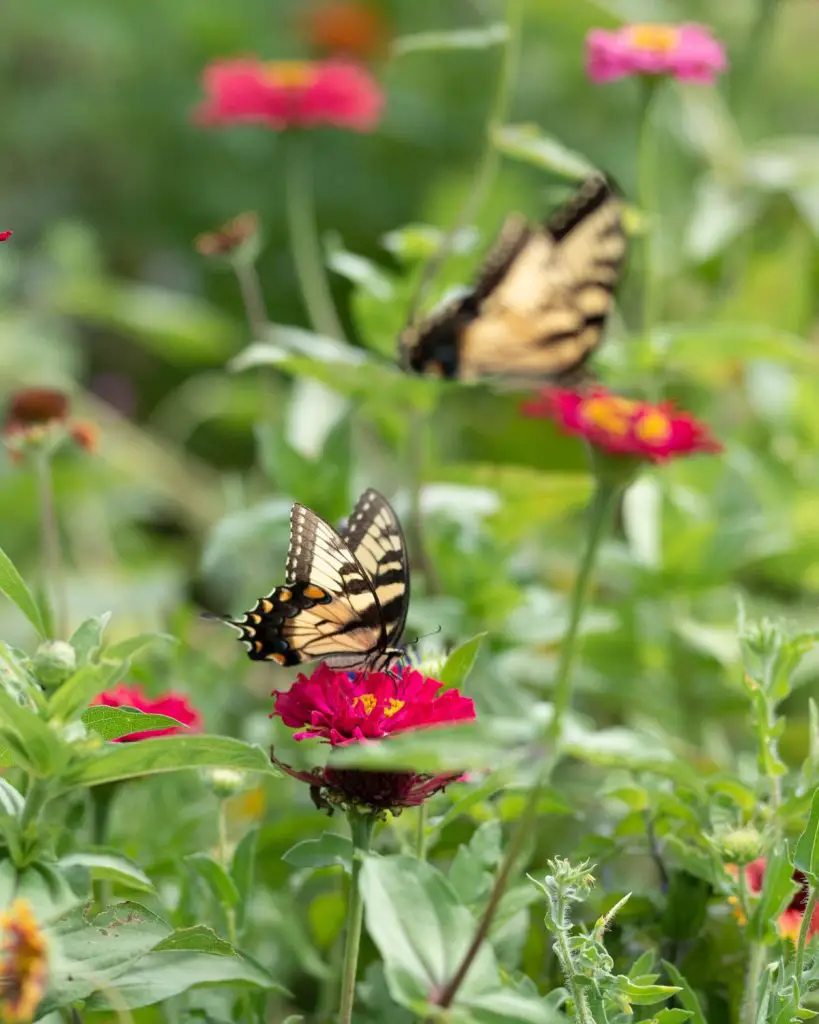Butterfly Gardens: How They Benefit the Environment
Butterfly gardens are becoming increasingly popular among gardeners and nature enthusiasts alike. These gardens are not only aesthetically pleasing but also serve an important purpose in the environment. Butterfly gardens provide a habitat for butterflies to thrive, which in turn, benefits the ecosystem.
Attracting butterflies to the garden by planting a variety of native and cultivated plant species help sustain plant diversity and attract other beneficial insects to the garden such as native bees and ladybugs. Butterflies are important pollinators and play a crucial role in the reproduction of many plants. They are attracted to bright flowers and need to feed on nectar. When they do this, their bodies collect pollen and carry it to other plants, which helps fruits, vegetables, and flowers to produce new seeds.
Moreover, butterfly gardens provide a safe haven for butterflies and their larvae, which are often threatened by habitat destruction and pesticide use. In addition to providing food and shelter, butterfly gardens also serve as a place for research and education. Students around the world use butterflies to study life cycles and insect migration. While a butterfly garden helps to provide an optimal environment for these beautiful insects, even a cultivated garden is affected by climate change. While climate change affects all living things, butterflies tend to be especially sensitive to changes.
Disclosure: As an Amazon affiliate, I earn from qualifying purchases at no extra cost to you. My blog contains other affiliate links as well for your convenience. To learn more, you may read my Disclosure Policy. Thank you for supporting my blog!
Understanding Butterflies and Their Importance
Butterflies are a type of insect that belongs to the order Lepidoptera, which also includes moths. These insects are known for their vibrant colors and delicate wings. Butterflies have a significant role in the ecosystem, and they are essential for the environment’s health.
Butterflies are important pollinators, and they help plants reproduce by carrying pollen from one flower to another. They are attracted to brightly colored flowers and need to feed on nectar. When they do this, their bodies collect pollen, which they carry to other plants, helping fruits, vegetables, and flowers produce new seeds.

Butterflies also play a crucial role in the food chain. Many animals that feed on insects, such as birds, bats, reptiles, and amphibians, consume butterflies. Therefore, butterflies are a part of the food chain, and their presence is essential for the survival of other species.
Butterflies are also sensitive to climate change, and they act as a barometer of how the environment is doing. Scientists monitor butterfly populations to detect early warning signs of problems affecting all living things, including humans. For example, monitoring Edith’s checkerspot butterflies in North America is one of the studies that involve monitoring butterflies as a method of watching for warning signs of the more widespread effects of climate change.
In conclusion, butterflies are an essential species in the ecosystem, and their presence is crucial for the environment’s health. Understanding the importance of butterflies can help people appreciate their role in the ecosystem and encourage them to take steps to protect these delicate and beautiful insects.
The Role of Butterfly Gardens
Butterfly gardens play a vital role in the environment by providing a habitat for these beautiful insects. They are not only aesthetically pleasing but also serve as a means of supporting the ecosystem. Here are some of the ways in which butterfly gardens help the environment:
Attracting Pollinators
Butterflies are important pollinators, and butterfly gardens help attract them to the area. By planting a variety of native and cultivated plant species, the garden can sustain plant diversity and attract other beneficial insects to the garden such as native bees and ladybugs. This helps in the pollination of plants, which in turn supports the growth of fruits, vegetables, and flowers.
Providing Habitat
Cultivating a butterfly garden helps to ensure that butterflies have a good habitat where they can reside. In addition to plants that are attractive to adult butterflies and edible for caterpillars, it is important to avoid the use of chemical insecticides and herbicides that can harm these sensitive insects. By providing a safe and healthy environment, butterfly gardens can help increase the population of these insects.

Get our
Secret Guide to Butterfly Gardening
Everything you need to start and maintain a vibrant and colorful butterfly garden.
Supporting Biodiversity
Butterfly gardens can also help support biodiversity. By planting a variety of plants, the garden can attract a range of different butterfly species. This, in turn, can help support other wildlife that is dependent on these insects for food. Additionally, butterfly gardens can help increase the genetic diversity of butterfly populations by providing a safe and healthy environment for them to thrive.
In conclusion, butterfly gardens play a crucial role in supporting the environment. They attract pollinators, provide habitat, and support biodiversity. By cultivating a butterfly garden, individuals can contribute to the health and well-being of the ecosystem.
Butterfly Gardens and Biodiversity
Butterfly gardens are a great way to support biodiversity in your local ecosystem. By providing a habitat for butterflies, you are also supporting a diverse range of other species, including birds, bees, spiders, lizards, and bats.
Butterflies are important pollinators, and the plants that they rely on for nectar and host plants are often also important food sources for other animals. By having a butterfly garden, you are creating a mini ecosystem that supports a wide range of species.
In addition to supporting pollinators and other animals, butterfly gardens can also help to increase plant diversity. By planting a variety of native and non-native plant species, you are creating a habitat that supports a range of different plant species. This can help to increase the overall biodiversity of your local ecosystem.
Butterfly gardens can also help to support specific butterfly species that may be in decline. By providing a habitat for these species, you are helping to ensure their survival and contributing to the overall health of the ecosystem.
Overall, butterfly gardens are a great way to support biodiversity and create a mini ecosystem in your own backyard. By providing a habitat for butterflies, you are also supporting a diverse range of other species, and helping to increase the overall health of your local ecosystem.

Plants in Butterfly Gardens
Butterfly gardens are designed to attract butterflies and provide them with food and shelter. One of the most important aspects of a butterfly garden is the plants that are used. Different butterfly species prefer different types of plants, so it’s important to choose a variety of plants that will attract a range of butterflies.
Nectar-producing plants are essential for butterfly gardens. These plants provide the butterflies with the energy they need to fly and reproduce. Some popular nectar-producing plants for butterfly gardens include snapdragons, crepe myrtle, lavender, and sedges. It’s important to choose plants that bloom at different times of the year to provide a steady supply of nectar throughout the growing season.
Native plants are also important for butterfly gardens. Native plants are adapted to the local climate and soil, making them easier to grow and maintain. They are also more likely to attract native butterflies and other pollinators. Milkweed is a particularly important native plant for butterfly gardens, as it is the only plant that monarch butterflies will lay their eggs on.
Butterfly gardens should also provide host plants for caterpillars. Caterpillars have specific plant preferences, so it’s important to research which plants are preferred by the butterfly species in your area. For example, monarch caterpillars feed exclusively on milkweed plants.
In addition to nectar-producing and host plants, butterfly gardens should also include trees and shrubs for shelter and protection. Trees and shrubs provide a habitat for butterflies during the winter months and offer protection from predators.
Overall, choosing the right plants for a butterfly garden is essential for creating a healthy and thriving ecosystem for butterflies and other pollinators. By providing a variety of plants that bloom at different times of the year, butterfly gardens can attract a range of butterfly species and contribute to the conservation of these important insects.

The Food Chain and Butterfly Gardens
Butterfly gardens are not only beautiful but also play a crucial role in the food chain. The plants in a butterfly garden provide food sources for various insects, including butterflies. These insects, in turn, become food for other animals, creating a chain of life that is essential for the environment.
The food sources in a butterfly garden are diverse, and they include fruits, vegetables, pollen, and nectar. Butterflies are attracted to bright flowers, and they feed on nectar, which is a crucial source of energy for them. When they feed on nectar, their bodies collect pollen, which they carry to other plants, helping with pollination. This process is essential for the growth and reproduction of many plants.
Butterfly gardens are also home to caterpillars, which are the larvae of butterflies. These caterpillars feed on the leaves of plants in the garden, and they are an essential food source for birds and other animals. Birds rely on caterpillars as a source of protein, especially during the breeding season when they need to feed their young.
In addition to providing food sources for insects and animals, butterfly gardens also play a vital role in maintaining the balance of the ecosystem. By attracting beneficial insects such as ladybugs and native bees, butterfly gardens help control pests naturally, reducing the need for harmful pesticides.
Overall, butterfly gardens are an important part of the food chain, providing food sources for insects and animals and helping to maintain the balance of the ecosystem.
Pollinators and Their Significance
Pollinators play a crucial role in maintaining the ecosystem and ensuring the survival of many plant species. Pollination is the process by which pollen from the male part of the flower is transferred to the female part of the flower, which results in the production of seeds. This process is essential for the reproduction of many plants, including those that provide us with food, such as fruits, vegetables, and nuts.
Pollinators are responsible for the majority of pollination in the world, and bees are the most well-known pollinators. However, other insects such as butterflies, moths, flies, and beetles, as well as birds and bats, also play a significant role in pollination.
Butterflies are efficient pollinators, and they are attracted to bright flowers and need to feed on nectar. When they do this, their bodies collect pollen, which they carry to other plants. This helps fruits, vegetables, and flowers to produce new seeds. By creating a butterfly garden, you are providing a habitat for butterflies and other pollinators, which helps to maintain the balance of the ecosystem.
Planting a variety of native and cultivated plant species in your butterfly garden can help sustain plant diversity and attract other beneficial insects to the garden, such as native bees and ladybugs. It is important to choose pollinator-friendly plants that bloom during each of the three blooming periods: spring, summer, and fall, to provide a continuous food supply for the pollinators.
In conclusion, pollinators play a significant role in the ecosystem, and butterfly gardens can help to provide a habitat for these important creatures. By creating a butterfly garden, you are not only providing a beautiful space for yourself but also contributing to the sustainability of the environment.
Caterpillars in the Ecosystem
Caterpillars play a crucial role in the ecosystem and are a vital part of the food chain. They are the larval stage of butterflies and moths, and they feed on the leaves of host plants. Caterpillars are an essential food source for many animals, including birds, reptiles, and small mammals.
Caterpillars are rich in protein and other nutrients, making them an important source of food for animals that need to build and maintain their bodies. They are especially important for birds during the breeding season when they need to provide food for their young. In fact, some bird species rely almost entirely on caterpillars to feed their chicks.
Caterpillars also play an important role in pollination. When they feed on the nectar of flowers, they transfer pollen from one flower to another, helping to fertilize plants and ensure their survival.
Furthermore, caterpillars help to maintain the balance of the ecosystem by controlling the population of host plants. They eat the leaves of these plants, which can prevent them from becoming too dominant and taking over other plant species.
In summary, caterpillars are a vital component of the ecosystem and play a crucial role in maintaining its balance. They are an important food source for many animals, help to pollinate plants, and control the population of host plants. Creating a butterfly garden that provides a habitat for caterpillars is an excellent way to support the ecosystem and promote biodiversity.

Protecting Butterfly Habitats
Butterfly habitats are under threat due to various human activities such as deforestation, habitat fragmentation, and climate change. Protecting butterfly habitats is crucial to the survival of these beautiful creatures and the environment as a whole. Here are some ways to protect butterfly habitats:
Conservation of Habitats
Conservation of butterfly habitats is essential to preserving these delicate creatures. Conservation efforts involve the protection of natural habitats such as forests, meadows, and wetlands. Conservation also includes the restoration of degraded habitats to their original state, which involves planting native plants and removing invasive species.
Climate Change
Climate change is a significant threat to butterfly habitats. Changes in temperature and weather patterns can affect the availability of food and water for butterflies. Conservation efforts must take into account the potential impacts of climate change and adapt accordingly.
Deforestation
Deforestation is one of the leading causes of habitat loss for butterflies. Forests are home to many butterfly species, and their destruction can have severe consequences. To protect butterfly habitats, it is essential to reduce deforestation and promote sustainable forestry practices.
Habitat Fragmentation
Habitat fragmentation occurs when natural habitats are divided into smaller, isolated patches. This can lead to a loss of genetic diversity and a decline in butterfly populations. To protect butterfly habitats, it is crucial to maintain large, connected habitats that allow for the movement of butterflies and other species.
In conclusion, protecting butterfly habitats is vital to the survival of these beautiful creatures and the environment. Conservation of habitats, climate change adaptation, reducing deforestation, and maintaining connected habitats are all necessary steps to protect butterfly habitats.

Must Have Monarch guide
Backyard Monarchs
the Ultimate Guide to Raising Monarch Butterflies
Butterfly Behavior and Adaptations
Butterflies are fascinating creatures that have adapted to survive in various environments. Understanding their behavior and adaptations can help in creating a suitable habitat for them in butterfly gardens. Here are some of the key behaviors and adaptations of butterflies:
Metamorphosis: Butterflies undergo a complete metamorphosis, which means they go through four distinct stages – egg, larva (caterpillar), pupa (chrysalis), and adult. This unique life cycle allows them to adapt to different environmental conditions and avoid competition with other species.
Flight and Wings: Butterflies have large, colorful wings that enable them to fly and escape predators. They can fly at different speeds, from hovering in place to soaring at high speeds. Their wings also help them regulate their body temperature, as they can bask in the sun to warm up or seek shade to cool down.
Colors and Patterns: Butterflies come in a wide range of colors and patterns, which serve different purposes. Brightly colored wings can attract mates, while duller colors can help them blend in with their surroundings and avoid predators. Some species also have eye spots on their wings to deter predators.
Puddling: Butterflies need moisture and minerals to survive, and they often gather in groups to drink from puddles, mud, or wet sand. This behavior, known as puddling, helps them replenish their nutrients and maintain their health.
Migration: Some butterfly species migrate over long distances to find suitable breeding grounds and food sources. For example, the monarch butterfly travels thousands of miles from Canada to Mexico each year. This behavior is crucial for their survival, as it helps them avoid harsh weather conditions and find new habitats.
Weather and Wind: Butterflies are sensitive to changes in the weather and wind patterns, which can affect their flight and migration. They may adjust their behavior and flight patterns to avoid strong winds or take advantage of favorable weather conditions.
In summary, understanding butterfly behavior and adaptations can help in creating a suitable habitat for them in butterfly gardens. Providing a variety of plants, water sources, and shelter can help attract and support butterfly populations.
The Impact of Butterfly Gardens on the Environment
Butterfly gardens have a significant positive impact on the environment. They provide a habitat for butterflies and other pollinators, which helps to maintain a healthy ecosystem. Here are some of the ways in which butterfly gardens help the environment:
- Pollination: Butterflies are important pollinators. They help to pollinate plants by transferring pollen from one flower to another. This process is crucial for the reproduction of many plants, including fruits and vegetables. By creating a habitat for butterflies, butterfly gardens help to support pollination in the surrounding area.
- Biodiversity: Butterfly gardens help to increase biodiversity in the environment. They provide a habitat for a variety of plant and animal species, which helps to maintain a healthy ecosystem. This is important because biodiversity is essential for the long-term health of the environment.
- Climate Change: Butterfly gardens can help to mitigate the effects of climate change. They provide a habitat for butterflies, which are sensitive to changes in temperature and weather patterns. By creating a habitat for butterflies, butterfly gardens can help to support these important pollinators even as the climate changes.
- Education: Butterfly gardens can also be used as an educational tool. They provide an opportunity for people to learn about the importance of pollinators and the role they play in the environment. This knowledge can help to raise awareness about the importance of protecting the environment and the species that depend on it.
Overall, butterfly gardens have a positive impact on the environment. They provide a habitat for butterflies and other pollinators, which helps to maintain a healthy ecosystem. They also help to increase biodiversity, mitigate the effects of climate change, and provide an educational opportunity for people to learn about the importance of the environment.

Shhh… don’t tell!!
5 Secrets to Starting a Garden
Enter your name & email so we can send your our FREE Guide.
Human Interaction and Butterfly Gardens
Butterfly gardens are not only beneficial for butterflies and the environment, but also for humans. These gardens provide an opportunity for people, especially children, to learn about the importance of butterflies and their role in the ecosystem.
However, it is important for humans to interact with butterfly gardens in a responsible and mindful way. The use of pesticides and herbicides should be avoided as they can harm not only butterflies but also other beneficial insects. Instead, natural pest control methods such as companion planting and crop rotation can be used to control weeds and pests.
Butterfly gardens should be planted in areas with full sun exposure to provide the necessary warmth for the butterflies to thrive. Additionally, providing shelter such as trees and shrubs can help protect the butterflies from strong winds and predators.
Overall, butterfly gardens can be a fun and educational way for people to interact with nature while also contributing to the preservation of the environment.
You may also enjoy these related articles:
- Grow Butterfly Weed for a Beautiful Butterfly Garden
- Plants for Butterfly Gardens: Attract More Butterflies to Your Yard with These Beautiful Flowers
- Plan Your Own Butterfly Garden: A Beginner’s Guide
Did you enjoy this article? Want to hear more? Stay in touch! Sign up below to receive weekly tips and inspiration for your homestead.
